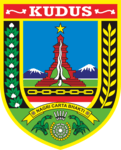Kudus Regency
Kudus (Javanese: ꦏꦸꦢꦸꦱ꧀) is a regency (Indonesian: kabupaten) in Central Java province in Indonesia. Its capital is Kudus. It is located east of Semarang, capital of Central Java.
Kudus Regency Kabupaten Kudus | |
|---|---|
 Seal | |
 Kudus Regency in Central Java | |
| Coordinates: 6°48′S 110°50′E | |
| Country | Indonesia |
| Province | Central Java |
| Districts | List
|
| Government | |
| • Acting Regent | Hartopo |
| Area | |
| • Total | 425.17 km2 (164.16 sq mi) |
| Population (2003) | |
| • Total | 813,000 |
| • Density | 1,900/km2 (5,000/sq mi) |
| Time zone | UTC+7 (WIB) |
| Post Code | 59300 |
| Area code(s) | 0291 |
| Website | kuduskab.go.id |
History

The city of Kudus was something of an important Islamic holy city in the sixteenth century. It is the only place in Java that has permanently acquired an Arabic name ('al-Quds', Jerusalem). Sunan Kudus, one of the nine Wali Sanga, was said to have been the fifth imam (head) of the mosque of Demak and a major leader of the 1527 campaign against 'Majapahit', before moving to Kudus.
The Mosque of Kudus (Masjid Menara) which dates from this period, remains a local landmark to this day. It is notable for both its perseverance of pre-Islamic architectural forms such as Old Javanese split doorways and Hindu-Buddhist influenced Majapahit-style brickwork,[1] and for its name al-Manar or al-Aqsa. The date AH 956 (AD 1549) is inscribed over the mihrab (niche indicating the direction of Mecca).[2]
Contemporary Kudus
Most residents of Kudus are Javanese although there is an Indonesian Chinese minority in the city centre, as well as an Arab neighbourhood, Kudus Kulon, to the west of the city centre.
The city is considered the "birthplace" of the kretek clove cigarette, which is by far the most widely smoked form of tobacco in the country. Haji Jamahri, a resident of the city, invented them in the 1880s, and the city remains a major centre for their manufacture.
A festival named Dandangan is held for about one whole month before Ramadhan, Muslim's fasting month in Kudus Kulon.
Anti-nuclear movement
On June 12, 2007, about 5000 people gathered peacefully to protest against Jakarta's plan to build 4 nuclear reactors in the region. The movement included local residents, activists, artists, students and public officials, parliament members, military commandants and police chiefs. This movement has been part of a series of responses emerging from all sides of the Indonesian society against the use of nuclear technology for energy production.
Notable people
- Hariyanto Arbi, badminton player
- Hermawan Susanto, badminton player
- Liem Swie King, badminton player
- Eddy Hartono, badminton player
See also
References
- Schoppert, P., Damais, S., Java Style, 1997, Didier Millet, Paris, 207 pages, ISBN 962-593-232-1
- Ricklefs, M.C. (1991). A History of Modern Indonesia since c.1300, 2nd Edition. London: MacMillan. p. 38. ISBN 0-333-57689-6.
